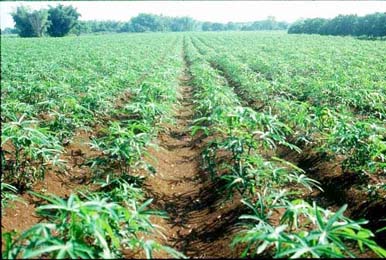Scientists working with the African Cassava Agronomy Initiative (ACAI), a scheme under International Institute of Tropical Agriculture (IITA), have identified some post-emergence herbicides to be used by farmer for cassava weed management.

The Principal Investigator on Weed Control Measures in IITA, Prof. Friday Ekeleme, made this known in a statement on Thursday, September 3, 2020 in Ibadan, Oyo State.
Ekeleme said these post-emergence herbicides, though not exclusive to cassava, had been adapted in the framework of the Six Steps to Cassava Weed Management and Best Planting Practices toolkit for use in cassava to control weeds.
He said that weeding in cassava was a tortuous and back-breaking exercise that limited the ability of farmers to expand their cropped area.
Ekeleme said that, in Nigeria, post-emergence herbicides include glufosinate ammonium, which is currently branded as Lifeline, Slasha Gold, Basta, among others.
”But fluazifop-p-butyl branded as Fusilade forte e.t.c. can also be applied if the weeds in the cassava field are grasses.
“The application of post-emergence herbicides requires care and skill to avoid damage to the cassava; this is because the post-emergence herbicides used in cassava are not selective.
“Mmeaning that they will harm cassava if they come in contact with the green parts of the cassava crop, including the green stems and the leaves.
“To avoid the post-emergence herbicides touching the green parts of cassava, farmers are encouraged to use spraying shields that are usually attached to the nozzle of the sprayer.
“There is however an exception, and that is, Fusilade Forte can be applied directly to the cassava crop to kill grasses (narrow leaf weeds only), if the field has a combination of both narrow and broad-leaf weeds, apply glufosinate ammonium,” he said.
Researchers in IITA have packaged the knowledge on the use of post-emergence and pre-emergence herbicides in cassava farming systems into an extension toolkit known as the Six Steps to Cassava Weed Management and Best Planting practices (simply called “Six Steps”), for dissemination to farmers.
The “Six Steps” is a set of agronomic recommendations including tillage and plant nutrition that enables farmers to grow cassava (or cassava intercropped with maize) with minimal interference of weeds, thereby pushing up the yield threshold of cassava.
ACAI has further bundled the toolkit into AKILIMO—a one-stop-shop advisory tool for farmers.
IITA Digital Extension and Advisory Services Specialist, Mr Godwin Atser, who is leading the dissemination of the “Six Steps” toolkit, said farmers were being advised to apply post-emergence herbicides only “when the cassava crop is eight weeks old and above’’.
Atser said post-emergence herbicides should be applied when weeds cover 30 per cent of the field and “are at four to six leaf stage.
Also, the IITA Director for Development and Delivery, Dr Alfred Dixon, called on farmers to follow the “Six Steps” for optimum control of weeds, stressing that the toolkit comprised all the recommendations necessary for weed control.
He stressed that the effective control of weeds was crucial for higher cassava productivity and urged farmers to contact IITA for the toolkit for the use on their farms.
By Chidinma Ewunonu-Aluko
